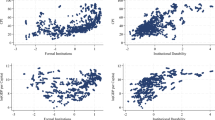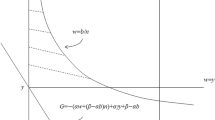Abstract
In this note we amend the model elaborated by Acemoglu and Verdier (2000, The American Economic Review, 90(1),194–211), to examine how agents respond to an exogenous change in incentives. In particular, we apply the theoretical framework to the consequences on the corruption level in Italy of a famous sentence of the Italian Corte di Cassazione in plenary session: in this sentence, no. 500 of 1999, a revolutionary interpretation of the law has increased the area of civil liability for both the public administration and bureaucrats. This is one of the few cases in which the judge substantially legislates in a system of civil law, and the modification in incentives towards or away from corruption comes from an authority that is not part of the game.
Similar content being viewed by others
References
Acemoglu, Daron, & Verdier, Thierry (2000). The choice between market failures and corruption. The American Economic Review, 90(1), 194–211.
Anoruo, Emmanuel, & Braha, Habtu (2005). Corruption and economic growth: The African experience. Mimeo.
Besley, Timothy, & Mclaren, John (1993). Taxes and bribery: The role of wage incentives. Economic Journal, 103(416), 119–141.
Clerico, Giuseppe (1996). Incentivi e sanzioni per combattere la corruzione del burocrate pubblico. Economia Pubblica, 26(3), 55–80.
Corte di Cassazione. (1999). Sentence no. 500 of July 22, 1999. Giustizia Civile, 49(9), 2261–2282.
Del Monte, Alfredo, & Papagni, Erasmo (2001). Public expenditure, corruption and economic growth: The case of Italy. European Journal of Political Economy, 17(1), 1–16.
Dreher, Axel, & Herzfeld, Thomas (2005). The economic costs of corruption: A survey and new evidence. Mimeo.
Ellickson, Bryan (1973). A generalization of the pure theory of public goods. The American Economic Review, 63(3), 417–432.
Huntington, Samuel P. (1968). Political order in changing societies. New Haven CT: Yale University Press.
Leff, Nathaniel (1964). Economic development through bureacratic corruption. American Behavioral Scientist, 8–12.
Longalavita, Fulvio (2004). L’esclusività della giurisdizione erariale e l’azione civile di danno in sede penale. Amministrazione e contabilità dello stato e degli enti pubblici, 5/6, 634–640.
Mauro, Paolo (1995). Corruption and growth. The Quarterly Journal of Economics, 110(3), 681–712.
Mo, Pak Hung (2001) Corruption and economic growth. Journal of Comparative Economics, 29(1), 66–79.
Pellegrini, Lorenzo, & Gerlagh, Reyer (2004). Corruption’s effect on growth and its transmission channels. Kyklos, 57(3), 429–456.
Petretto, Alessandro (1998). Riforma della Pubblica Amministrazione, riforma del bilancio ed efficienza economica. Le Regioni, XXVI(5), 1161–1172.
Relazioni annuali dei Presidenti dei Tribunali Amministrativi Regionali resi in occasione dell’apertura degli anni giudiziari. (2006) Various issues (see http://www.giustizia-amministrativa.it).
Rose-Ackerman, S. (1978). Corruption: A study in political economy. New York USA: Academic Press.
Rose-Ackerman, S. (1999). Corruption and government: Causes, consequences, and reform. Cambridge UK: Cambridge University Press.
Scoca, Franco Gaetano (1988). Interessi protetti (dir. amm.). Enciclopedia Giuridica (Treccani). Roma: Istituto Enciclopedico Italiano.
Shleifer, Andrei, & Vishny, Robert (1993). Corruption. The Quarterly Journal of Economics, 119(3), 599–617.
Shi, Shouyong, & Temzelides, Theodosios (2004). A model of bureaucracy and corruption. International Economic Review, 45(3), 873–908.
Tietenberg, Tom (1992). Environmental and natural resource economics. New York: HarperCollins Publishers.
Wei, Shang-Jin (2001). Corruption in economic development: Grease or sand? United Nations Economic Commission for Europe, Economic Survey of Europe Geneva.
Acknowledgments
Thanks to the Editor and two anonymous referees, Marlies Ahlert, Salvatore Capasso, and participants at the seminars held at University of Catania, First Annual Conference of Italian Society of Law and Economics (ISLE), Siena (Italy), November 25–27, 2005, and Annual Workshop of the European Master Program in Law and Economics at the University of Hamburg, Hamburg, Germany, February 10, 2006, for their invaluable suggestions and comments on a previous draft of this paper. All remaining errors are the responsibility of the author.
Author information
Authors and Affiliations
Corresponding author
Rights and permissions
About this article
Cite this article
Di Vita, G. A note on exogenous changes in incentives for and deterrence of corruption. Eur J Law Econ 24, 15–27 (2007). https://doi.org/10.1007/s10657-007-9019-5
Received:
Accepted:
Published:
Issue Date:
DOI: https://doi.org/10.1007/s10657-007-9019-5




